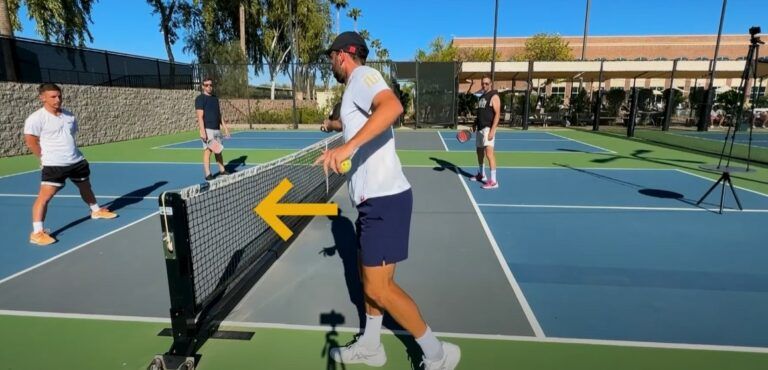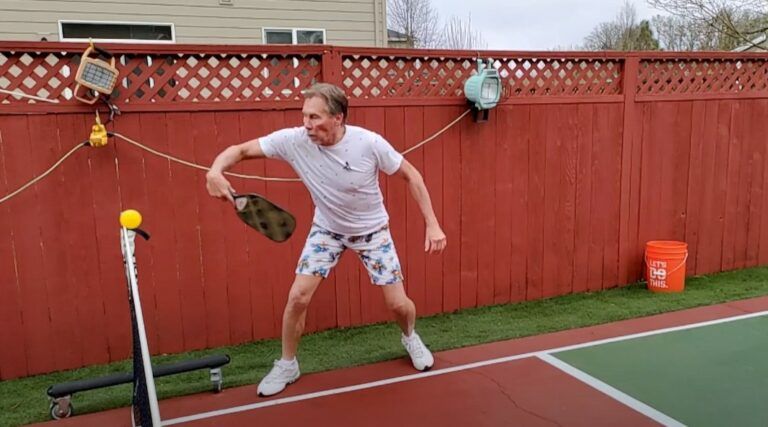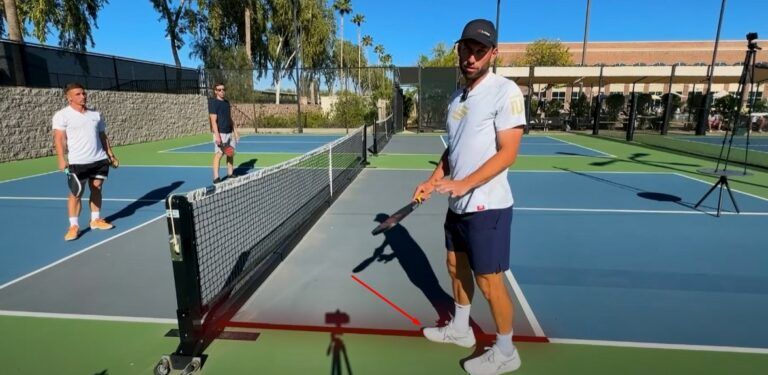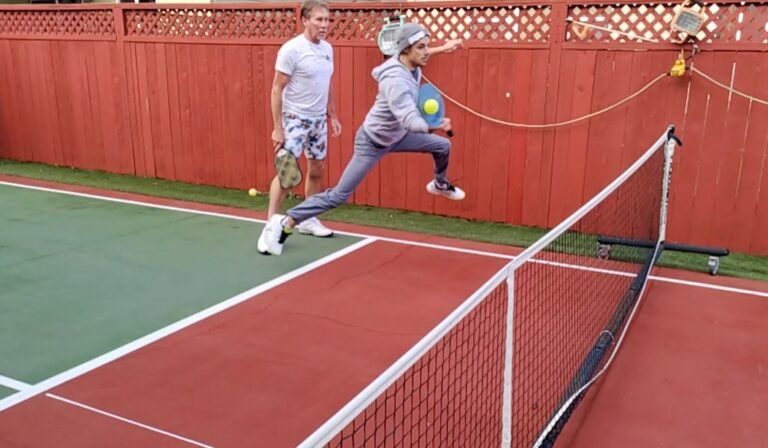What is an erne in pickleball?
The erne is an advanced volleying technique in pickleball, where a player executes a shot from just outside the court's side boundary while remaining outside the non-volley zone, also known as the kitchen. This maneuver is particularly effective because it allows players to strike the ball mid-air, often catching their opponents unaware. The erne can shift the momentum of a game with its surprise factor, especially during dinking rallies or when an opponent anticipates a halting, safe return.
Visual representations, such as video clips or instructional images, can dramatically enhance the understanding of this technique. When executed correctly, the erne embodies the essence of agility and anticipation two traits every pickleball player aspires to possess.

Key points:
- Positioning: The player positions themself near the net, outside the kitchen boundary.
- Timing: Successfully executing an erne requires watching the ball's descent and timing the hit when it is high enough to score.
- Surprise Element: This technique often catches opponents off guard, making it an effective tactical weapon.
Why is it called an erne?
The name erne has its roots in the player who popularized this remarkable shot: Erne Perry. His innovative approach to the game brought this advanced technique into the limelight, and it has since become associated with competitive play. Notably, videographer Jeff Shank recorded Perry's effective use of the erne during matches, showcasing how seemingly simple movements could lead to utterly dynamic plays.
In the realm of pickleball, where tradition and modernity coexist, understanding the genesis of the erne offers players a glimpse into the evolution of this sport. It serves as a reminder that innovation often stems from the brilliance of individual players who dare to push boundaries.

Interesting tidbits:
- Pioneers of the game: Erne Perry is celebrated not just for popularizing the erne, but for his contributions in shaping modern competitive pickleball.
- Cultural Shift: The erne symbolizes an aspect of gameplay that embraces unpredictability and skill.
Is an erne legal? Understanding the rules
An integral part of mastering the erne involves understanding the legality of the shot, particularly in relation to the non-volley zone. In pickleball, players must adhere to specific rules that govern when and where they can volley. One primary restriction is that players are not allowed to step into the kitchen while attempting a volley. This makes positioning crucial when preparing to execute an erne.
To successfully launch an erne while abiding by the pickleball Game's rules, it's essential to establish that both feet are positioned firmly outside the kitchen and sideline before making contact with the ball. These rules underscore the importance of precise movement and timing, reinforcing the complexity of executing this seemingly straightforward maneuver.

Key legal considerations:
- Kitchen Restrictions: No partial feet within the kitchen while hitting the ball.
- Foot Placement: Both feet must be outside the non-volley zone and sideline.
When to unleash the erne: Recognizing the opportunity
Recognizing when to utilize the erne can significantly improve a player’s tactical edge. Ideal situations tend to arise during dinking rallies, especially when opponents are close to the sideline. For instance, if an opponent is positioned near the sideline, they might return a deep shot, providing the opportunity to execute an erne. Anticipating these moments requires keen observation and quick reflexes.

Understanding your opponent's movements and positioning not only prepares you to perform an effective erne but can also help you dictate the rhythm of the game. This strategic element highlights one of the many layers involved in pickleball, where anticipation and timing play essential roles in achieving success.
Examples of ideal situations:
- Dinking Rallies: Utilizing the erne when engaged in prolonged exchanges that involve soft shots.
- Anticipated Deep Shots: Expecting a return that goes down the sideline.
How to hit an erne: Step-by-step guide
Executing an erne successfully involves a series of precise movements and keen anticipation. Here’s a step-by-step guide outlining three primary methods in detail:

Running around the kitchen
- Positioning: Start near the net while ensuring one foot remains outside the sideline.
- Anticipate: Watch your opponent and predict their shot, preparing to move.
- Swift Movement: Move toward the ball, stepping outside the sideline with one foot while keeping the kitchen rules in mind.
- Timing: As the ball approaches, ensure it’s at the right elevation, allowing for a powerful hit without timing errors.
- Execute: Use a smooth swing to game control and deliver a strong volley.
Running through the kitchen
- Establishing It Legally: Drag your back foot while allowing your other foot to enter the kitchen, ensuring that you remain compliant with the rules.
- Footwork: It’s crucial to practice this method repeatedly to achieve the desired flow and avoid mistakes.
- Momentum: Your body should be in motion toward the net, ensuring a robust follow-through on your shot.
Jumping over the kitchen
- "Superman" Technique: This involves a leap over the kitchen while still managing to strike the ball on the way down.
- Preparation: This requires agility and should only be attempted by those comfortable with timing their jump effectively.
- Visuals for Guidance: Professional videos often demonstrate the mechanics behind this maneuver, providing visual insights that can be beneficial for learners.
Benefits of the erne: Why it's a powerful weapon
Understanding the wealth of advantages offered by the erne reveals why it is treasured among competitive players. The surprise element is perhaps the most significant benefit, allowing you to take your opponents off guard. Moreover, delivering a powerful volley close to the net can also enhance the pressure exerted on them, often forcing unforced errors.
As players refine their execution of the erne, they learn how to control the pace of rallies. This technique not only promotes aggressive gameplay but instills an air of unpredictability that can alter the tempo of matches, enhancing both challenge and entertainment value for all involved.
Advantages include:
- Catching opponents off guard: The surprise aspect transforms a rally into an offensive spectacle.
- Aggressive volleys: Allows for a proactive approach, making returns increasingly challenging for opponents.
Risks of the erne: When not to attempt it
Like any advanced technique, the erne does come with risks. One major concern is the potential for being out of position; if the shot fails or is poorly timed, it could result in the player being far away from the court, leaving them vulnerable to counterattacks. Additionally, seasoned players might anticipate the setup. The erne, while a dynamic tool in any player’s arsenal, must be employed with an understanding of these implications.
Players need to assess their position on the court and their opponents' readiness before unleashing this shot. Weighing the potential risks against the rewards is vital for a strategic approach to the game.
Notable risks:
- Being out of position: A failed attempt could leave you exposed.
- Experienced opponents: Skillful rivals may read your setup and counteract your move effectively.
Defending against the erne: Protecting your court
For players wishing to defend against the erne, recognizing the warning signs of its setup becomes paramount. This section aims to equip players with beginner-friendly strategies to counteract potential erne attacks by observing their opponent’s movements and positioning, allowing for better defensive formations.
Recognition of setup:
Understanding when an opponent is preparing for an erne can significantly aid in your defensive strategy. Moments where dinking rallies escalate give a strong indication.
Defensive options:
- Dinking cross-court: This strategic play can force opponents to cover more ground, complicating their setup for an erne.
- Hitting lobs: This can ask the opponent's partner to shift coverage, providing defensive opportunities.
Practice makes perfect: Erne drills for beginners
Practicing the erne is essential for honing the skills necessary for successful execution. Partner drills focusing on footwork and timing can substantially enhance a player's preparedness. Starting slowly and gradually increasing speed is crucial to developing not only confidence but also refining muscle memory.
Effective drills may include:
- Partner exchanges: Practicing the erne in controlled exchanges allows players to focus on precision.
- Footwork drills: Engaging in exercises targeting foot movement will ensure smoother execution.
Beyond the erne: Introducing the "bert"
Once players become proficient in executing the erne, they may explore the advanced variation known as the bert. This shot entails a similar concept but originates from the partner’s side of the court. Understanding this technique can broaden a player’s tactical maneuvers, integrating advanced strategies into their gameplay.
This discussion of the bert serves as an invitation to expand one’s pickleball repertoire, illustrating the notion that each shot can lead to new tactical developments on the court.
Points to ponder:
- Advanced variations: The bert demonstrates how learning can open avenues for new strategies.
- Next levels of learning: This encourages continuous development in a player's gaming practices.
In conclusion, mastering the erne not only enhances a player’s skill set but also enriches the overall dynamics of competitive play. By understanding the nuances of execution, timing, and positioning, players can harness this powerful shot to gain a tactical advantage. Moreover, as players refine their approach, they embark on a journey of continuous improvement that resonates with the heart of pickleball: strategy, agility, and unexpected moves that redefine gameplay. Observing the wonders this technique can achieve will undoubtedly serve as a testament to the art of pickleball itself.










